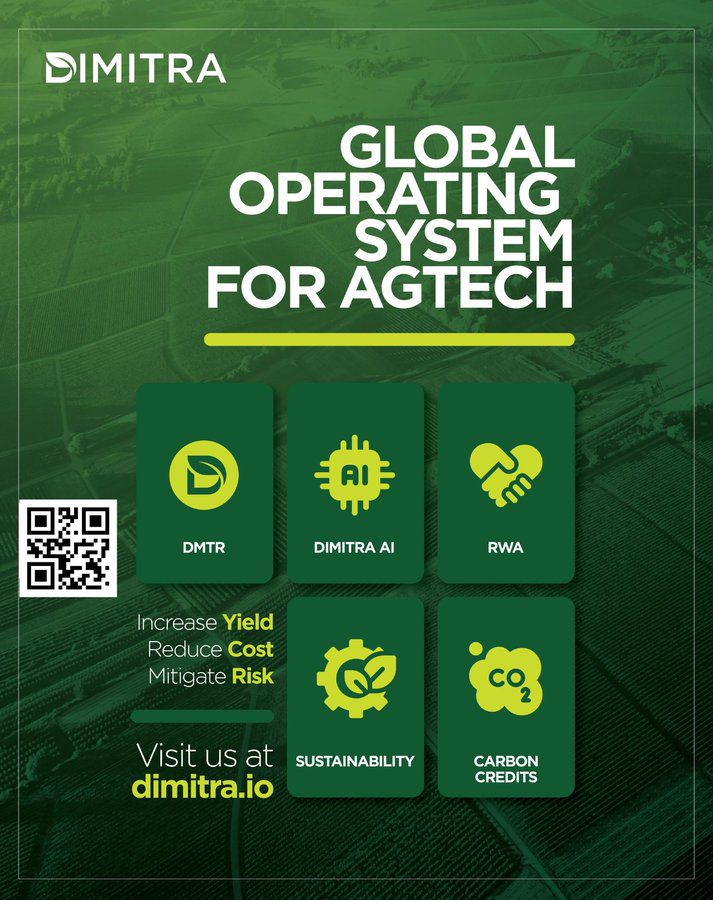Dimitra is emerging as a pivotal player in the AgTech industry, providing a global operating system that leverages AI to assist millions of farmers and companies worldwide. The platform, represented by the $DMTR token, is gaining traction for its innovative approach to agriculture, integrating advanced technologies to enhance productivity, sustainability, and profitability in farming.
Harnessing AI for Agricultural Excellence
Artificial Intelligence (AI) is at the core of Dimitra’s operations, offering tools that analyze agricultural data to provide actionable insights. This technology helps farmers manage risks, forecast environmental challenges, and optimize crop yields. AI’s role in agriculture is not just limited to data analysis. It also extends to automating tasks such as self-driving tractors, drones for crop health monitoring, and smart cameras for weed recognition.
Dimitra’s Impact on Global Food Security
With the world’s population expected to reach nearly 10 billion by 2050, the demand for food is set to increase significantly. Dimitra’s AI-driven solutions are crucial in meeting this demand by improving access to credit for farmers, enhancing yield predictions, and promoting sustainable farming practices. The platform’s ability to forecast natural disasters, crop diseases, and erosion helps farmers mitigate risks and ensure consistent food production.
Innovations in AgTech: A Look at Dimitra’s Competitors
The AgTech sector is witnessing a surge in innovations, with companies like Traive and Cropin making significant strides. Traive, for instance, has facilitated nearly $1 billion in financial operations by using AI to analyze agricultural data and assess risk for lenders, thereby giving farmers easier access to credit. Similarly, Cropin has partnered with Google’s Gemini to launch Sage, an agri-intelligence tool that forecasts crop output and weather impact based on historical data.
The Role of Robotics and Automation in Modern Farming
Robotics and automation are transforming traditional farming practices. Companies like Farm-ng are developing modular agricultural robots that can perform various tasks such as seeding, weeding, and compost spreading. These robots are designed to be cost-effective and customizable, catering to diverse farming needs. The integration of AI with robotics not only enhances efficiency but also addresses labor shortages in the agricultural sector.
Sustainability and ESG in Agriculture
Sustainability is a key focus for Dimitra and other AgTech companies. AI-driven solutions help manage climate risks and promote sustainable farming practices. For instance, Kilimo uses soil analysis and satellite imagery to optimize irrigation, thereby incentivizing sustainable water use in agriculture. Such innovations are crucial in addressing the challenges posed by climate change and ensuring the long-term viability of farming.
The Future of AgTech: Opportunities and Challenges
The future of AgTech looks promising, with continuous advancements in AI, robotics, and data analytics. However, there are challenges to be addressed, such as ensuring equitable access and managing the ethical implications of increased automation. As the industry evolves, it will be essential to balance technological innovation with sustainability and social responsibility.
Conclusion
Dimitra is at the forefront of the AgTech revolution, leveraging AI and advanced technologies to transform agriculture. By providing farmers with the tools they need to increase yields, manage risks, and operate more sustainably, Dimitra is contributing to global food security and the future of farming. As the industry continues to grow, the integration of AI and robotics will play a crucial role in shaping the future of agriculture.
Ready to Transform Your Hotel Experience? Schedule a free demo today
Explore Textify’s AI membership
Explore latest trends with NewsGenie
